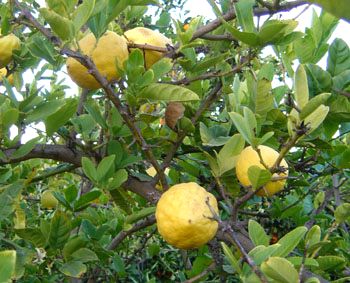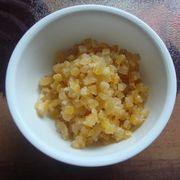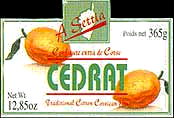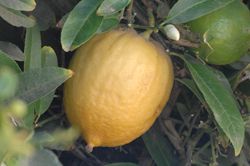|
|||||||||
Select any of 50 available languages! |
|||||||||
Citron |
||
| Citrus medica |
| History Distribution Uses Preparation of candied peel Classification Citron in other languages The history of the name citron Citron |
|
| 'Kivelevitz' citron © Jorma Koskinen |
History
Uses
Preparation of candied peel, succade.
Classification of citron
Citron in other languages
The history of the name citron
|
| LAT | Citrus medica L. |     |
| Syn | Citrus
medica var.
cedrata
Risso Citrus aurantium var. medica Wight & Arnott Citrus crassa Hassk. Citrus medica var. medica |
|
The top picture shows a variety of citron cultivars, some of which are described further down. The thick peel that is candied is clearly visible. The candying method is described above. In the second picture there are six different kinds of citron. The size and shape of the fruit varies greatly between varieties. The clustered flowers of the acidic varieties have a purplish outer tint, but the sweet ones are yellowish-white. The acidic varieties include the Italian and Diamante citron from Italy, the Etrog (Greek citron) and the Balady citron from Palestine. The sweet varieties include the Corsican and Moroccan citrons. The pulpless citrons include some Fingered varieties and the Yemen Citron. The citron tree is very vigorous with almost no dormancy. It blooms several times a year, therefore it is fragile and extremely sensitive to adverse weather. |
||
| ENG | Citron | |
| FRA | Cédrat, Citronnier des juifs | |
| GER | Zedrate, Zedrat-Zitrone, Zitronat-Zitrone, Judenapfel | |
| I TA | Cedro, Cedrato | |
| ESP | Cidra, Cidro, Cidrero, Poncil | |
| FIN | Sukaattisitruuna | |
| SWE | Suckatcitron, Sötcitron, Cedratträd (tree) | |
| Photos | (1,2) © Petr
Broža (3) © C. Jacquemond / INRA © UCR Citrus Variety Collection |
|
| LAT | Citrus medica ’Balady’ |   Lefkowitz Chazon Ish   Halperin Chazon Ish |
| Syn | Citrus medica 'Chazon Ish' |
|
|
Balady Citron is a variety of Israeli citron, or etrog, grown in Palestine for Jewish ritual purposes. Its characteristics much resemble those of the Etrog (Greek citron) variety described further down. Balady is Arabic for "native". Local Arab farmers began using this name in the mid-19th century to distinguish this variety from the Greek citron, which was cultivated along the Jaffa seashore. The Balady was grown on the outskirts of Nablus and neighbouring Nazareth, near Safed and Alma al-Shaib, in Umm al-Fahm, in an orchard near Tiberias, and in Lifta village near Jerusalem. Rabbi Chaim Elazar Vacks (b. 1822) believed that this variety of etrog has the strongest tradition-lineage of species purity, being found in the wilderness of Israel when the first settlers, including Nahmanides (1194 – c.1270), arrived there. While the variety is not domesticated, it is not grafted and does not require intensive cultivation techniques. Subsequently it was always used by famous scholars and pious persons, who were certainly convinced of its purity and suitability for religious rituals. For other eligible citron varieties see Etrog.The Balady or Chazon Ish citron has two main cultivars: the Halperin Chazon Ish, the Lefkowitz Chazon Ish. The Chazon Ish (Rabbi Avrohom Yeshaya Karelitz, 1878-1953, popularly known for his important book Chazon Ish) once saw a certain citron tree and pronounced "This is an Esrog". The seeds from that Esrog were planted by Rabbi Michel Yehuda Lefkowitz and have given rise to the Lefkowitz type. The Chazon Ish saw another Esrog and told its owner Yakov Halperin to plant its seeds. This gave rise to the Halperin strain. The importance of the difference between the two strains for the Chazon Ish has remained unclear. Wikipedia has a detailed article on the Balady citron. It describes its history and competition with the Greek Citron (the 'Etrog' variety) in religious rituals. |
||
| ENG | Balady citron, Chazon Ish citron | |
| FRA | ||
| Photo | (1) © Shoteh (2) © Jorma Koskinen (3) © CitricAsset (4) © Gene Lester |
|
| LAT | Citrus medica ’Braverman’ & 'Kivelevitz' |  Braverman   Kivelevitz |
|
Rabbi Yehoshua Yehudah Leib Diskin, (1818–1898), also known as the Maharil Diskin, was reported to be the first witness of a citron tree in the village of Petach Tikva. He pronounced the tree an esrog and told the owners of the tree to cultivate it and plant new trees from its seeds. The Braverman family propagated the tree and started the Braverman cultivar. The fruit is cone-shaped and resembles the Balady variety. The surface is often rough and deeply corrugated. Kivilevitz is a substrain selected from the Braverman citron. Both the Braverman and the Kivelevitz are acceptable varieties to be used as esrog during Sukkot. For other varieties see Etrog. |
||
| ENG | Braverman and Kivelewitz citrons | |
| FRA | ||
| GER | ||
| Photo | © Jorma Koskinen |
|
| LAT | Citrus medica 'Fingered' ('Buddha's Hand') |  The Fingered citron  Cut fingered citron with no pulp  Buddha's hand (a corrugated citron)  Variegated Buddha's hand |
| Syn |
Citrus medica var. sarcodactylis (Hoola van Nooten) Swingle Citrus medica var. digitata (Lour.) Risso |
|
The Buddha's Hand citron (the bushukan of Japan), also known as the Fingered citron, is a fragrant, strongly aromatic variety that has long been used as an offering in temples. In earlier times it was much used as an insect repellent and an air-freshener. It is cultivated in Japan and China where at least a dozen named cultivars exist. The fruit is split into five or more finger-like segments. In outward appearance there are two main strains of the Fingered citron: one where the whole fruit is fingered (two top pictures) and another where only part of fruit is fingered or the whole fruit is only corrugated without separate fingers (two bottom pictures). The fruit often has no pulp but consists entirely of the edible fleshy peel that can be steamed and candied fresh (second picture). It is also prepared as candied peel by the traditional method The fruit in the bottom picture is of a variegated Buddha's Hand with bi-coloured leaves. Wikipedia has a good article on the Fingered citron. |
||
| ENG | Buddha's Hand, Fingered citron | |
| FRA | Cédrat main de Bouddha | |
| GER | Gefingerte Zitronat-Zitrone | |
| I TA | Cedro a mano di Budda | |
| ESP | ||
| SWE | Fingercitron | |
| DAN | Buddhafinger | |
| Photos | (1,3) © Jorma Koskinen (2) © Joe Real (4) © Laaz |
|
| LAT | Citrus medica ’Diamante’ |    |
| Syn | Citrus medica 'Cedro Liscio' Citrus medica 'Yanover' |
|
'Diamante' fruit is ellipsoid and unlike most citrons the peel is smooth or only faintly ribbed. It has a very thick rind and firm, fleshy albedo. Flesh is crisp; lacking in juice, but acid, like lemon. The fruit has a broad nipple at the apex. Commercially grown in Italy's Calabria region, the Diamante citron is easily recognised by its 'square shoulders'. Tree is small, open and spreading, medium-thorny with some large, stout spines; buds, flowers, and new growth purple-tinted. Presumably of local though unknown origin, Diamante is the principal variety of Italy and is considered to be the best. It was introduced into the United States in 1898. Italian and Sicilian are California introductions that are similar to Diamante. Diamante is one of the citrons appropriate for Jewish religious rituals. When used as etrog the variety is called by its Hebrew name Yanover. The name derives from the town of Genoa, which used to be the main export harbour for Italian citrons. For other suitable varieties see Etrog. Wikipedia has a good article on the Diamante citron. |
||
| ENG | Diamante citron. | |
| GER | Glatte Zedrat-Zitrone | |
| I TA | Cedro liscio | |
| Photo | © Jorma Koskinen | |
| LAT | Citrus medica 'Etrog' |    |
| Syn | Citrus medica var. ethrog Engl. Citrus medica 'Greek' Citrus medica 'Corfu' Citrus limonimedica Lush. |
|
The variety name Etrog is a misunderstanding. Etrog (Ethrog, and the Esrog of Ashkenazi Jews) is the Hebrew name for citron. Since this Greek variety was one of the main varieties grown in Israel it eventually became known as the variety 'Etrog'. The origin of the Etrog variety is unknown (see History) and sometimes it is thought that this variety may be close to one of the original citrus fruits out of which all other citrus types have hybridised. See Introduction, The genus Citrus. The variety was initially known to be cultivated on the Ionian Islands, of which Corfu is the most prominent, which is why the Hebrews sometimes call it Corfu etrog. Nowadays not a single citron tree is found on that island, but it is still cultivated on some other Greek Islands e.g. Crete and Naxos. The citron is no longer exported from Greece for the ritual purpose. Cretan citron growers sell it for the candied peel, which is called succade, and in Naxos it is also distilled into a special aromatic liqueur called kitron. In the Feast of Tabernacles (sukkot) the first fruit of the new harvest are brought to the temple in a bunch (Lulav) of four plants, one of which is the etrog, a citron. For this Jewish religious ritual certain other types of citron can be used as well. The tree has to grow on its own roots and not be grafted. The colour, shape and unblemished rind of the fruit have to accord with strict rules. Furthermore the citrons have to be grown under the supervision of an appointed rabbi. The other varieties accepted as a ritual etrog are 'Yanover' (Diamante), 'Balady', 'Moroccan' (the Assads cultivar) and 'Yemen' and such Israeli selections as Braverman and Kivelevitz. The Etrog variety is also called 'Greek' or 'Corfu' citron.Wikipedia has an interesting article on the Etrog variety under the name Greek Citron. |
||
| ENG | Etrog citron, Greek citron, Corfu citron | |
| FRA | Cédrat Etrog | |
| GER | Hebräische Zedrat-Zitrone | |
| Photos | (1) © CCPP (2) © Joe Real (3) © Trade Winds Fruit |
|
| LAT | Citrus medica ’Italian’ |  |
| Syn | ||
Fruit of the Italian variety is very similar to Diamante above, but the rind is less thick, being about 1/3 of fruit cross sectional radius whereas Diamante rind comprises about 1/2 of the fruit radius. The tree bears a heavy crop of relatively large fruits, which are markedly elongated; some have a tapered apex. The juice and rind have a pleasant flavour. |
||
| ENG | Italian citron | |
| I TA | ||
| Photo | © UCR Citrus Variety Collection | |
| LAT | Citrus medica ’Moroccan’ |   |
|
The Moroccan sweet citron was first described in detail by Professor Henri Chapot in his article Un curieux cédrat marocain, which he published in 1950. He found that the acidity in the more common citrons and lemons is linked to violet pigmentation on the outer side of the flower and the reddish-purplish colour of the buds. The Moroccan citron, which is acidless and sometimes used as a replacement for the Corsican completely lacks red colour. Chapot found two cultivars: Assads and M'Guergueb. The Assads cultivar of the Moroccan citron is one of the varieties that are suitable for use as etrog in Jewish religious rituals. The lower picture is of a Moroccan etrog hanging to adorn a Sukkah. There was originally some doubt about the non-hybridised purity of the Moroccan, because certain strains did not have seeds. When the Assads cultivar was found to have an almost ideal fruit shape and seeds as well it was accepted as pure citron. Wikipedia has a good article on the Moroccan citron. |
||
| ENG | Moroccan citron | |
| FRA |
Cédrat marocain | |
| Photo | © Satmarer © Yankelowitz |
|
| LAT | Citrus medica ’Sicilian’ |   |
Sicilian is a medium to large elongate citron with a blunt nose. Skin is smooth but bumpy, furrowed and yellow. The rind is medium thick. The flesh has a small central core. It is very seedy, sour but fairly juicy, with a nice, tart citron flavour. Otherwise it appears to be very similar to Diamante. |
||
| ENG | Sicilian citron | |
| FRA | ||
| Photo | © UCR Citrus Variety Collection | |
| LAT | Citrus medica ’Yemen’ |  
|
| Syn | Citrus medica 'Temoni' |
|
|
The fruit of Yemen is sweet and has a pleasant flavour. Medium size on average, size varies from small to large. The shape of the fruit is irregular, most fruits are elongate, many with pointy nose. The fruit matures late. Rind is yellow, rough, very thick, fluted, especially at apex. Yemen citron has no juice vesicles. Strips of rind albedo connect around seeds to solid central core. Albedo flavour is sweet but very mild. This could be described as a "dry" citron. Yemen is one of the citrons appropriate for Jewish religious rituals. For other suitable varieties see Etrog. Also called Yemenite and Temoni citron. Wikipedia has an article on the religious aspects of the Yemenite citron. |
||
| ENG | Yemen citron, Temoni citron | |
| FRA | ||
| Photos | © Jorma Koskinen | |
Julia Morton's book Fruits of Warm Climates has an extensive article on citron.
Wikipedia has a good article on citron.

|
|



















